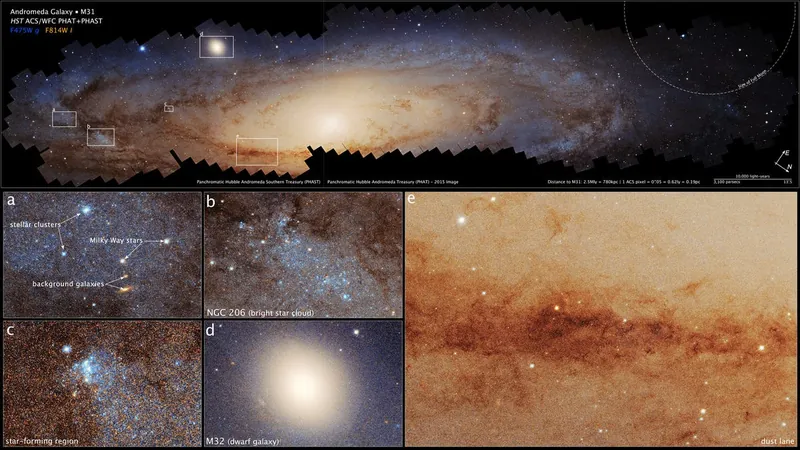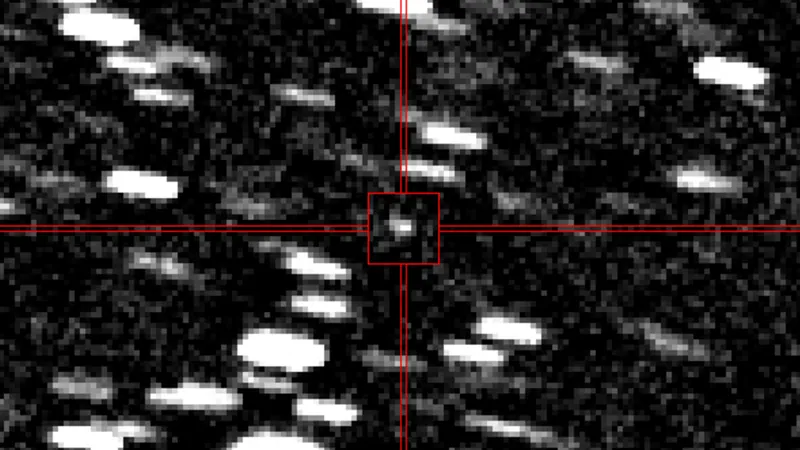
See the Stunning Andromeda Galaxy Like Never Before! NASA's Latest Images Reveal Cosmic Secrets!
2025-01-23
Author: Ting
NASA Unveils Breathtaking Images of Andromeda Galaxy
NASA has unveiled breathtaking images of the Andromeda galaxy, often described as an "enticing empire of stars" that can be glimpsed with the naked eye under optimal weather conditions. This remarkable cosmic structure is about 2.5 million light-years away from our Milky Way and has captivated astronomers since Edwin Hubble first identified it as a "magnificent" spiral nebula over a century ago.
Groundbreaking Survey by Hubble Space Telescope
In a groundbreaking survey, the Hubble Space Telescope captured unprecedented details about Messier 31—highlighting its significance as the closest spiral galaxy to our own and a window into the evolution of galaxies. Without Andromeda, our understanding of the Milky Way's structure would be considerably less comprehensive, as NASA emphasizes.
Insights from Principal Investigator Ben Williams
According to Ben Williams, a principal investigator at the University of Washington, “With Hubble, we can get into enormous detail about what’s happening on a holistic scale across the entire disk of the galaxy,” showcasing the telescope's unmatched capability to study distant cosmic giants.
A Staggering Number of Stars
The enchanting images reveal a staggering 200 million stars brighter than our sun, although estimates suggest that the galaxy contains about 1 trillion stars in total. This monumental survey represents over a decade’s worth of observations, encompassing more than 1,000 Hubble orbits and approximately 600 unique fields of view, compiled into a mesmerizing mosaic comprising at least 2.5 billion pixels.
Insights into Andromeda's Formation History
Further analysis of Andromeda has revealed intriguing insights into its formation history. Scientists discovered that Andromeda is home to a higher population of younger stars and features coherent streams of stars, indicating an active recent history of star formation and galactic interactions—more so than what is observed in the Milky Way. Daniel Weisz, an associate professor of astronomy at the University of California, Berkeley, remarked, “Andromeda’s a train wreck. It looks like it has been through some kind of event that caused it to form a lot of stars and then just shut down,” likely due to a past collision with another galaxy.
Interesting Regions Labeled A to E
This extensive study has labeled several "interesting regions" within the galaxy from A to E, appearing in what NASA calls the “largest photomosaic ever” created by the Hubble Space Telescope. This discovery not only sheds light on the past of Andromeda but paints a vivid picture of the dynamic processes at play in our universe.
Observation Opportunities for Skywatchers
For skywatchers wanting to catch a glimpse of this magnificent galaxy, note that planetary alignments may provide a unique opportunity for observation—mark your calendars! Don’t miss the chance to connect with the cosmos and witness the wonders that lie beyond our own galaxy.



 Brasil (PT)
Brasil (PT)
 Canada (EN)
Canada (EN)
 Chile (ES)
Chile (ES)
 Česko (CS)
Česko (CS)
 대한민국 (KO)
대한민국 (KO)
 España (ES)
España (ES)
 France (FR)
France (FR)
 Hong Kong (EN)
Hong Kong (EN)
 Italia (IT)
Italia (IT)
 日本 (JA)
日本 (JA)
 Magyarország (HU)
Magyarország (HU)
 Norge (NO)
Norge (NO)
 Polska (PL)
Polska (PL)
 Schweiz (DE)
Schweiz (DE)
 Singapore (EN)
Singapore (EN)
 Sverige (SV)
Sverige (SV)
 Suomi (FI)
Suomi (FI)
 Türkiye (TR)
Türkiye (TR)
 الإمارات العربية المتحدة (AR)
الإمارات العربية المتحدة (AR)